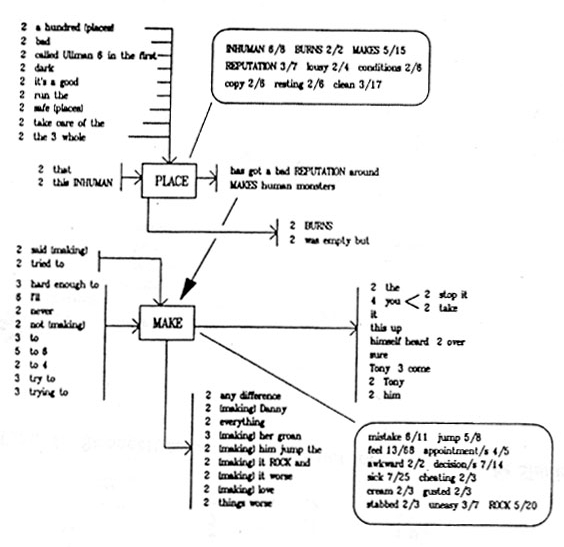Introduction
This paper will consist a discussion of some of the theoretical assumptions underlying the design of a piece of software and a demonstration of its function. This software, the Fixed Phrase Tool is part of the first release of TAPoR (text analysis portal for research). I first saw the desirability of such software while doing my doctoral dissertation in Toronto, a computer-aided text analysis of the semantics of story and tale in Chaucer. It was clear that the lists generated by traditional texts analysis tools such as TACT were both tedious to examine and presented information in a serial fashion that was not suitable to data that were, in some sense, relational. It was also clear that attempts to reformat the output of such 'listware' into more relational forms is exceedingly laborious. Of course, this practical need presupposes certain assumptions about meaning, which follow this rough outline.
Theory
But if both meanings, or all of them. . . remain ambiguous after the faith has been consulted, then it is necessary to examine the context of the preceding and following parts of the ambiguous place, so that we may determine which of the meanings among those which suggest themselves it would allow to be consistent.
(Augustine, 2.2)
The value of the chess pieces depends upon their position upon the chess board, just as in the language each term has its value through its contrasts with all the other terms.
(Saussure 88)
For a large class of cases —though not for all— in which we employ the word 'meaning' it can be defined thus: the meaning of a word is its use in the language.
(Wittgenstein 20e)
You shall know a word by the company it keeps!
(Firth 179)
We assume in the design of this software a view of language that sees the meaning of a word as inextricably linked to its contexts, a view that is in some ways foreshadowed in Augustine's advice to readers of Scripture to resolve semantic ambiguities by examining the context of a passage
(3.2.2). To some extent, our software's function and design is also informed by a Saussurean structuralist semantics that holds that a word's meaning is "determined by the [horizontal] paradigmatic and [vertical] syntagmatic relations"
(Lyons 268) between that word and others in a system of language. This is illustrated in Saussure's example of the game of chess in which the value of individual pieces is not the result of any intrinsic qualities but rather of their relation to other pieces
(Saussure 108, 87 ff.). Of course, the method of deducing what a word named (its reference) for Augustine becomes a mode of meaning for Wittgenstein, and while Saussure's focus is upon a word's place within a language system (its sense), that of Wittgenstein is upon a word's place within instances of discourse.
J. R. Firth was perhaps the first linguist to give Wittgenstein's statement serious consideration when he proposed that one could define a word by looking at its linguistic context, or "the mere word accompaniment, the other word-material in which [a word is] most commonly or most characteristically embedded"
(Firth 180). Seeking to differentiate this from context of situation, Firth called it collocation
(195). In a sense, this study of collocation, the linguistic material or linguistic context within which a word commonly occurs, involves the mapping of pathways leading to and from each word
(Palmer 76). Firth's idea of collocation, first presented in 1951, introduced a new type of word meaning, but would have to await the introduction of computers and electronic texts before it could be used to study texts of any significant size
(Berry-Rogghe 103). His ideas have most famously borne fruit in the COBUILD dictionaries and grammar and in the field of corpus linguistics. The collection and classification of collocates require the computer's unique ability to perform repetitive tasks quickly and efficiently. Software like TACT brought this ability to desktop PC users and thus solved the problem of collection, but introduced a new set of challenges, one of which was how to represent the data gathered by such tools. A multitude of familiar paths lead off from these words in every direction. (Wittgenstein 143e, 144e)
During the initial phases of memory encoding, it is as if one is preserving the shape of a letter by walking a particular route on a lawn. The pattern is dynamic, and is only evident in the way one moves. After a period of time, however, the grass will wear through, creating a dirt pathway. At that point, one can stop walking; the information is preserved structurally (Kosslyn & Koenig, 351)
The significance of a collocate lies repetition and syntagmatic relation. Therefore, the Fixed Phrase Tool (FPT) focuses on collecting phrasal repetends, a subclass of collocation. As Ian Lancashire has noted, phrasal repetends fall into two categories: "repeating fixed phrases" in which word order is unchanging and "repeating collocations, in which words co-occur, although in varying order, sometimes with words intervening"
(100). Repeating fixed phrases (fixed phrases hereafter) may most closely represent the network of familiar paths that constitute a person's language. From a neuroscientific perspective, as Lancashire has noted, they are the result of such paths (188 ff). He also attempted to represent these neurological structures in what he called "phrasal repetend graphs"
(217) .

Figure 1
We have adopted this model fully in the FPT. Although it outputs the standard list of fixed phrases, the tool can also automatically format such lists into a form very much resembling that above, though, at present showing only fixed phrases. The neurological and philosophical roots of the path model of meaning also imply a degree of interactivity. This is implemented in the Java version of the FPT, where each node word in the graph can itself become a node in its own graph.